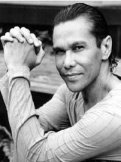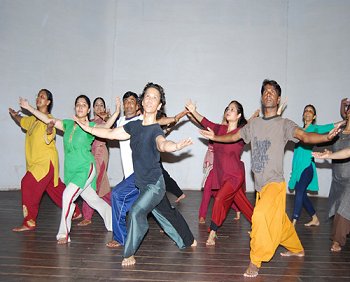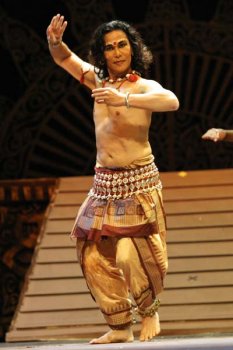
|
 |

|
 |
Ramli Ibrahim conducts WDA Dance Workshop at Bangalore - Vani Madhav, Bangalore e-mail: vani_madhav2000@yahoo.com May 28, 2009  Vani Madhav, Odissi dancer and member of World Dance Alliance (Bangalore) interviewed Ramli Ibrahim, artistic director of Sutra Dance Theatre (Kuala Lumpur) on his approach to the contemporary motivational and choreographic workshop which he had conducted in Bangalore, at the Seva Sadan Auditorium from 3rd May to 6th May. How did you find yourself in Bangalore conducting this workshop? I was able to do this workshop because Sutra was touring India with 'Rasa Unmasked' and 'Spellbound' that took in performances in Bangalore. So, it was convenient for me to incorporate this workshop into my schedule. About a year ago in April 2008, I conducted a workshop on invitation by Madhu Nataraj for STEM, Bangalore. I enjoyed it tremendously but due to a mistake in my flight schedule, I was not able to complete it fully. I felt I had short-changed the participants and I knew that they were also disappointed. At the back of my mind, I felt I owed it to them that I should complete the workshop. So, when the opportunity arose as I was able to be in Bangalore for the tour, I agreed to do the workshop on WDA's request. Otherwise, it would not have been cost permitting. What did you try to achieve in this four-day workshop? The major intention of the workshop was the introduction of the basic concepts of choreographic design. However, the emphasis was to cultivate this from Asian perspectives particularly that of Indian dance. When we talk of contemporary modern dance choreographic skills, the points of reference have tended to be western. I wanted the participants to be aware that ideas for contemporary modern dance could also be inspired by indigenous forms and by cultivating this viewpoint, their works can be more authentic, distinctive and interesting. The second intention is to introduce participants to Sutra's body-conditioning and contemporary dance technique classes. Sutra approaches its technique class from a 'neutral' standpoint. Ours is very eclectic approach and our contemporary classes, by sheer necessity, give effective warm-ups and hopefully, getting the maximum result in the minimum time usually available for the dancer. Unabashedly drawing from yoga, ballet and modern dance techniques, Sutra dance classes are generally fast paced and prepares its dancers for the onslaught of the contemporary Asian choreographer in the most efficient manner. In the midst of this is the emphasis on improvisation as the key to unlocking creativity and in discovering movement for choreography. In the improvisation session, we explore the particular motif or sense of movement under examination and then collectively and constructively evaluate what we had explored. Through this the dancers begin to gain confidence and insight to fundamentals in compositional design.  Who were the participants that turned up for your workshop and how did you find their response to your exercises? The participants were various dancers and choreographers from the Bangalore dance community. Most participants had Bharatanatyam background and some were Odissi dancers. Some had training in contemporary modern dance techniques and there were also participants who had exposure in yoga and dance therapy methods. The participants had different levels of expertise. I found that they all, without exception, had an open attitude and were eager to benefit from the program. This was very refreshing and I came to the conclusion that this may be the attitude of Bangaloreans who, generally speaking, have less 'baggage' and preconceived notions of what is 'good' or 'bad' about dance. What are the challenges you think face dancers in Bangalore? Survival and also living up to one's ideal is always the major challenge for any true artiste everywhere. In Bangalore, the classical dancers seem to have more opportunities as compared to contemporary modern dancers and groups. For classical dancers everywhere there is that challenge of not always resorting to the same clichéd way of presenting classical repertoire and for the modern dancers, there is the exciting challenge of exploring and breaking new grounds outside the event promotion type of presentation which has become the staple 'bread and butter' performance of most 'modern' groups in Bangalore. Generally speaking Bangalore dancers want their work to be seen outside Bangalore and to do this they need access to more funds and sponsorships. They feel that as they are not placed in the dance centres such as Delhi or Chennai, they are not noticed enough and their requests are ignored. Naturally they want their work to be seen in the major cities like New Delhi, Mumbai or Chennai and there seems to be less chance of getting that slice of the funding cake from central arts agencies, which are not in Bangalore.  How do you yourself define 'contemporary,' 'modern' and 'choreography' in the context of growing Asian awareness of performing arts, especially when traditional and classical arts abound and are also evolving and being created as we speak? There has been some confusion when these three words are being used especially in the context of dance in South Asia and Southeast Asia. The problem arises as these terminologies have largely been associated with and defined from the point of view of their western progenitors and the image-makers of modern dance, most of whom saw dance from their western perspectives. But in the last twenty years, contemporary modern dance movement have taken wings in Asia and have evolved independently from their western counterpart. For instance, contemporary modern choreographers of Asia no longer look at New York as the mecca of modern dance and find the post-modern and post-post modern movement that originated from New York alien to what they are searching, say, in India or even in Malaysia. So, I feel that the word 'modern dance' has to be eventually re-defined from its indigenous milieu. Major Asian choreographers who were first inspired by Martha Graham or Limon, eventually seek their own identities through delving and finding their own voices and languages. This sentiment is presently being felt in Asia - in India and Southeast Asia included. Of course, there will always be the few incorrigible ones like me who ply the boundaries of both East and West like some art terrorists debunking existing categories…Eventually for us, there is only good dance. The categories should serve as means and not ends. Modernism has always been a reaction to the frequently stultifying presence of 'tradition.' Modern minds have always tended to be 'individualistic' and rebel against the shackling hold of tradition. I guess Uday Shankar for me is the original Indian modern dancer of real influence whereas Rukmini who had very modern ideas, was mainly an innovator within the Indian classical tradition. Thus her role in reviving the declining traditional classical forms was seminal in projecting classical dances to its present esteemed stature but almost to the detriment of modern dance movement as represented by Shankar. It was a pity as India could have had both. Now India finds that its modern dance movement lags behind its classical when the latter has reached a certain saturation point. I feel choreography is about finding new ways of moving and designing movement. I don't think the rearrangement of Bharatanatyam adavus is part of the art of choreography. This should be a compositional and arrangement exercise as the core work has been taken from existing vocabulary. It has its own creativity but it is not what I understand by choreography. Choreography is very much an individualistic creative grappling with a design challenge and making an effective statement with the movement created. Constructing and deconstructing a thirmanam in Bharatanatyam is not choreography and has become more of a 'cut-and-paste' job. There are some grey areas where both choreography and compositional skills which are employed in traditional works are employed but nowadays nothing is so black and white. But the word 'choreography' has been so clichéd that it is stands for everything…it would just as well mean 'curry-graphy' or 'choro-graphy'. As for the word 'contemporary,' I do think that the word should mean what it stands for - which is 'of the time.' In Asia, especially India, classical dances are being created as we speak and these dances are also contemporaneous with our time. Some classical dancers are also claiming that they are as contemporary as any modern dancers and they've got a point! You mentioned the term 'Apollonian' and 'Dionysian' principles in your workshop. Can you explain these terminologies? I remember attending a wonderful workshop on choreography by the late Glen Tetley who was not only a choreographer whom I admired but also who had a very clear understanding of the fundamentals of design. It was Tetley who first introduced me to looking at these two principles which influence the direction and balance of intent of the dance-creator. Apollonian principle is about balance, symmetry, equilibrium and predictability. It produces order and discipline in a design and even in a character. It is more or less 'executive' and requires virtuosity to sustain audience interest. I think the Kalakshetra school of Bharatanatyam is very much a personification of the Apollonian principle. On the other hand, Dionysian principle has to do with chaos, asymmetry, disequilibrium and unpredictability. Dionysian people tend to be highly creative and iconoclastic rather than executive in nature. Movement of Dionysian nature tend to attract attention more easily but the span of interest is short. Rock music is highly Dionysian. The tribhanga is Dionysian in design and therefore is highly enigmatic, asymmetrical and compelling. The chauka on the other hand, is Apollonian and is the perfect personification of balance. Therefore, the tension created between the combination of these two stances makes Odissi very watchable. On the other hand, Bharatanatyam, especially the Kalakshetra school has to be executed by a highly virtuosic dancer to sustain interest - otherwise, it is quite predictable and boring. |